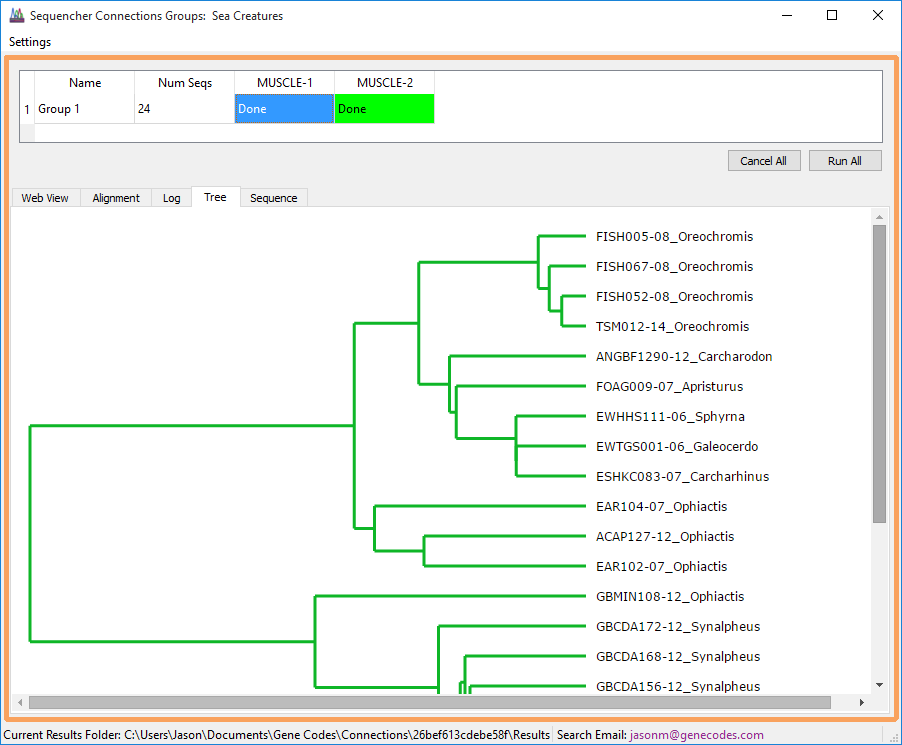

You can read more about Aligner, and download demo versions, at ConsedĬonsed was developed specifically for use with Phred and Phrap.Consed offers a interactive functions as well as powerful methods for"autofinishing" - automatic picking of additional sequence reads andwalking primers to close gaps and eliminate low-quality problems inlarge scale sequencing projects.
#SEQUENCHER FOR FREE MAC OS#
Consed is the tool of choice very large projects,or for high-throughput operations that can make use of Consed's "autofinish"features.Ĭonsed is available only for Linux and UNIX, including Mac OS X.
#SEQUENCHER FOR FREE FOR FREE#
On Mac OSX, Consed requires that X11 (freely available from Apple) is installed.įor academic users and restricted research use, Consed is available for free directly from the authors. For more information on obtaining Consed for free for restricted academic use, please visit Consed licenses and support for unrestricted use and use atfor-profit institutions are available through CodonCode. Please fillout our informationrequest form for pricing information. Gap4 is part of the "Staden package", and was developed by RodgerStaden, James Bonfield, and coworkers at the MRC Cambridge. Gap4 andthe preprocessing program Phregap4 offer a number of powerfulinteractive features, as well as options to integrate Phred and Phrapfor base calling and assembly. One potential downside is that it cantake a long time to get familiar with the powerful features Gap4offers. Gap4 is available for UNIX, Linux, and Windows, and is free toacademic users.For more information about Gap4, please visit the Stadenpackage home page. Sequencher is a popular package for Sequence assembly and editingdeveloped by Gene Codes Corporation (no affiliationwith CodonCode Corporation). The newest releases of Sequencher, version4.1.2 and newer, can import PHRAP-generated assemblies.

In a test project with more than 800 reads, MacPHRAPassembled the project much faster and into fewer contigs thenSequencher:Ĥ5 minutes 39 seconds (Phred quality scores used) Even just using PHRED-generatedquality scores to perform quality-based end trimming often leads to betterassemblieswith fewer gaps and discrepancies.įor larger sequencing projects with several hundred reads, forexample cosmid or BAC shotgun projects, the combination ofMacPHRED-MacPHRAP with Sequencher 4.1.2 can give faster and betterresults. Sequencher assemblies were run with default setting and two differentpre-processing steps.ġ. In one project, sequence traces without PHRED qualities were used,and ends where clipped using the default settings. This assembly ledto a large number (70) of small (3,305 bp or shorter) contigs.Ģ. Next, the same sequences were imported with PHRED quality scores,and clipped using quality information. This assembly led tosubstantially fewer (11) and larger (up to 17,386 bp) contigs. In comparison, the MacPHRAP assembly was done more than 40-foldfaster, and led to only two contigs, the larger one covering most ofthe cosmid (44,459 bp). Please note that importing Phrap assemblies into Sequencher can sometimes lead to "holes" in contigs, because Sequencher may clip ends incorrectly when importing Phrap assemblies. Other potential problems and workarounds with importing Phred results into Sequencher are listed on the Sequencher trouble shooting page.įor more information about Sequencher, please visit more information about using PHRED quality scores in Sequencher,please visit CodonCodeAligner - CodonCodesupport - CodonCodeHome - Phrap.Exocellular DNA is operationally defined as the fraction of the total DNA pool that passes through a membrane filter (0.1 μm). It is composed of DNA-containing vesicles, viruses, and free DNA and is ubiquitous in all aquatic systems, although the sources, sinks, and ecological consequences are largely unknown. Using a method that provides separation of these three fractions, we compared open ocean depth profiles of DNA associated with each fraction. Pelagibacter-like DNA dominated the vesicle fractions for all samples examined over a depth range of 75 to 500 m. Viral DNA consisted predominantly of myovirus-like and podovirus-like DNA and contained the highest proportion of unannotated sequences. Euphotic zone free DNA (75 to 125 m) contained primarily bacterial and viral sequences, with bacteria dominating samples from the mesopelagic zone (500 to 1,000 m).


 0 kommentar(er)
0 kommentar(er)
